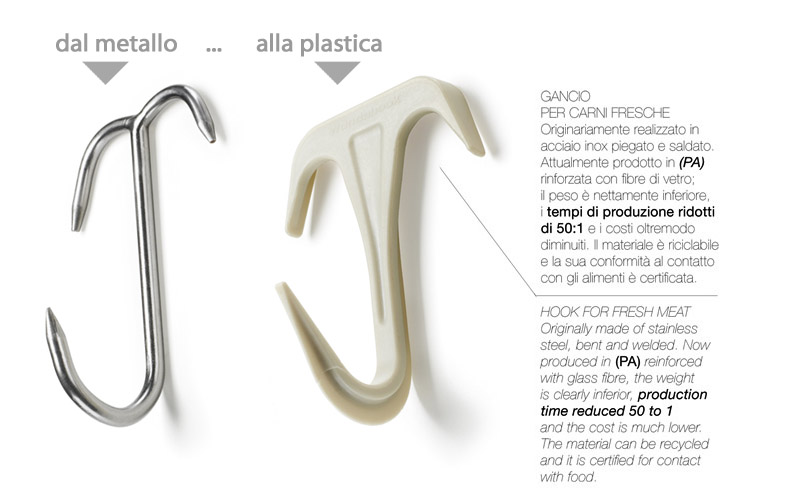THE CHALLENGE
Is there an alternative technology for making meat hooks (currently made from stainless steel) which offers economical savings while still having the same technical resistance?
What plastic can be used to replace the metal in order to reduce production times, being as currently the manufacture of hooks requires different processes such as bending and welding?
THE SOLUTION
Engineering
Our team of engineers was convinced that it was possible to convert the stainless steel meat hook into a similar product made from plastic.
The feasibility study began with reverse engineering, a technique used to digitalize existing physical objects which is fundamental for the correct analysis and remodelling of the geometric surfaces and was completed with an accurate FEM (finite element method) analysis which, through simulations of hook use in standard conditions provided us with useful data for understanding which part of the piece was at most risk of deformation or the most fragile in situations of strain.
In this way we were able to optimize the geometry of the part and identify the most suitable technopolymer to use for its production: glass fibre reinforced PA6. This is a material which, thanks to the glass fibre reinforcement, has optimum mechanical properties such as tensile strength, rigidity and hardness. It also has good thermal dimensional stability and good resistance to chemical agents and limits water absorption. It is also a recyclable material and is food-contact certified by the FDA.
Prototype
Once the definitive 3D mathematics had been obtained, a sintered nylon prototype was made so that checks and resistance testing could be performed to confirm the effectiveness of the project, allowing us to proceed with the next stage of engineering and making the moulds.
Mould engineering and construction
Csplast engineered and made an injection mould designed to produce the technopolymer hook.
RESULT
The redesigning of the meat hook gave rise to a new and innovative product: what had been produced exclusively in metal yesterday is today moulded from plastic. This translates into a 50:1 reduction in production costs and times, not to mention an improvement in the effectiveness and functionality of use. Furthermore, use of the plastic meat hook comes with the benefits of being lighter, stronger and more hygienic. This resulted in the huge satisfaction of our client who greatly improved his production efficiency and contributed to further increasing the already proven experience of PlastDesignStudio in engineering technical articles in plastic.


